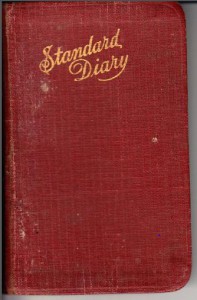 If your family is anything like mine, you heard plenty of stories about your great-grandparents from your parents. From those stories I have been able to get a sense of their personalities and how they lived, but it is a view limited to how my parents knew them as their grandparents. Learning who your ancestors were as young adults is difficult, since most standard documents do not reveal an individual’s personality. My mother has a genealogical file on each of my relatives, where she keeps news clippings or other documents pertaining to their lives, which I often refer to while I am researching my family. During my last visit home, while searching through her files, I discovered the diary of my great-grandmother, Gladys Tompkins, from the year 1924. Continue reading Insights from my great-grandmother’s diary
If your family is anything like mine, you heard plenty of stories about your great-grandparents from your parents. From those stories I have been able to get a sense of their personalities and how they lived, but it is a view limited to how my parents knew them as their grandparents. Learning who your ancestors were as young adults is difficult, since most standard documents do not reveal an individual’s personality. My mother has a genealogical file on each of my relatives, where she keeps news clippings or other documents pertaining to their lives, which I often refer to while I am researching my family. During my last visit home, while searching through her files, I discovered the diary of my great-grandmother, Gladys Tompkins, from the year 1924. Continue reading Insights from my great-grandmother’s diary
Tag Archives: Object Lessons
The Le Roy family register
 Here at NEHGS, we are always on the lookout for interesting genealogical books, pedigrees, or other formats for documenting family history. One of my first blog posts here covered the Society’s acquisition of a fascinating (and literal) family tree showing all of Queen Victoria’s descendants at the time of her Diamond Jubilee in 1897. Recently, I was directed to – and subsequently acquired – a Le Roy family register compiled by my cousin Edward Augustus Le Roy (1833–1913), one that showed all the descendants of the Le Roy immigrant down to about 1890. Continue reading The Le Roy family register
Here at NEHGS, we are always on the lookout for interesting genealogical books, pedigrees, or other formats for documenting family history. One of my first blog posts here covered the Society’s acquisition of a fascinating (and literal) family tree showing all of Queen Victoria’s descendants at the time of her Diamond Jubilee in 1897. Recently, I was directed to – and subsequently acquired – a Le Roy family register compiled by my cousin Edward Augustus Le Roy (1833–1913), one that showed all the descendants of the Le Roy immigrant down to about 1890. Continue reading The Le Roy family register
Gravestones and name changes
 Anyone who has researched genealogy knows that names can be spelled many different ways across a variety of records. I once found twelve different spellings of one family’s surname during a research project here at NEHGS. Recently, in my own personal family research, I’ve realized that another problem can occur when names are shortened across the generations. Continue reading Gravestones and name changes
Anyone who has researched genealogy knows that names can be spelled many different ways across a variety of records. I once found twelve different spellings of one family’s surname during a research project here at NEHGS. Recently, in my own personal family research, I’ve realized that another problem can occur when names are shortened across the generations. Continue reading Gravestones and name changes
Serendipity in genealogy
 There is much serendipity in genealogy: more than once I have pulled a book off the shelf in the library at NEHGS, intrigued by the title or perhaps the binding, only to find within its covers the answer to a vexing research question or a story that sheds light on a forgotten family member. One such volume is H.U. Memoirs, published in Boston in 1886, the earliest Harvard class book – not including the Sibley’s Harvard Graduates volumes – on the Society’s open shelves. In it I found a charming short biography of my great-great-great-great-uncle George James Foster (1810–1876), written by his niece Caroline Healey Dall. Continue reading Serendipity in genealogy
There is much serendipity in genealogy: more than once I have pulled a book off the shelf in the library at NEHGS, intrigued by the title or perhaps the binding, only to find within its covers the answer to a vexing research question or a story that sheds light on a forgotten family member. One such volume is H.U. Memoirs, published in Boston in 1886, the earliest Harvard class book – not including the Sibley’s Harvard Graduates volumes – on the Society’s open shelves. In it I found a charming short biography of my great-great-great-great-uncle George James Foster (1810–1876), written by his niece Caroline Healey Dall. Continue reading Serendipity in genealogy
“Dam humbug”!

Among my husband’s family papers is a letter, dated 25 October 1873, from John Dill to his mother, Susan (Berry) (Dill) Gibbons. John had left the family home in Springfield, Illinois, earlier that year to work on the railroad in Texas, and he was alarmed about the impending marriage of his younger sister, Ida Dill:
This thing of Ida getting acquainted Courting and marrying all in about a month I do not believe in and more than it is a dam humbug. . . . How do you know what that fellow is or has bin you cant find out so much in such a little time. Continue reading “Dam humbug”!
More than just names and addresses
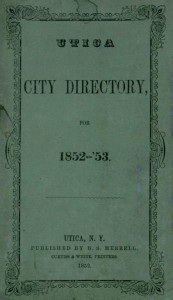 In my role as a technical services librarian at NEHGS, one of my regular activities is selecting books from our research library for digitization, and in recent months I’ve been focusing on some of the nineteenth century city directories from our rare books collection. City directories can have great research value: in addition to pinpointing the exact years that an ancestor inhabited a particular place, they often provide data about occupation and employers, and can be an especially good resource for locating information about individuals who may have been renters or temporary residents. Continue reading More than just names and addresses
In my role as a technical services librarian at NEHGS, one of my regular activities is selecting books from our research library for digitization, and in recent months I’ve been focusing on some of the nineteenth century city directories from our rare books collection. City directories can have great research value: in addition to pinpointing the exact years that an ancestor inhabited a particular place, they often provide data about occupation and employers, and can be an especially good resource for locating information about individuals who may have been renters or temporary residents. Continue reading More than just names and addresses
A primer on current copyright law
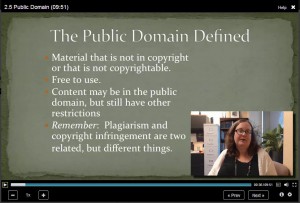
In this information age, many of us worry about others sharing pieces we have written, scanned, or recorded. What we may not consider, but should, is whether we ourselves have the right to use, donate, or sell certain items.
Recently, I participated in a four-week online course on copyright (for teachers and librarians) via Duke University. Meanwhile, my colleague Sally Benny attended a two-day education session during the Society of American Archivists (SAA) conference in Washington, D.C. Continue reading A primer on current copyright law
A question of attribution
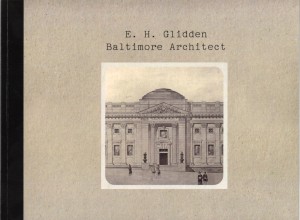 A by-product of finishing a project and publishing the results is that one moves on – without necessarily losing interest in the subject matter. I spent about five months immersed in the study of my great-grandfather Edward Hughes Glidden’s architectural oeuvre, producing two books at Shutterfly.com about my findings: the first, E. H. Glidden: Baltimore Architect, is illustrated with historic images of his buildings, and the second (Glidden’s Baltimore: Works by Edward Hughes Glidden) is largely filled with 2014 photographs from a spring trip to Maryland. Continue reading A question of attribution
A by-product of finishing a project and publishing the results is that one moves on – without necessarily losing interest in the subject matter. I spent about five months immersed in the study of my great-grandfather Edward Hughes Glidden’s architectural oeuvre, producing two books at Shutterfly.com about my findings: the first, E. H. Glidden: Baltimore Architect, is illustrated with historic images of his buildings, and the second (Glidden’s Baltimore: Works by Edward Hughes Glidden) is largely filled with 2014 photographs from a spring trip to Maryland. Continue reading A question of attribution
Detective Stories
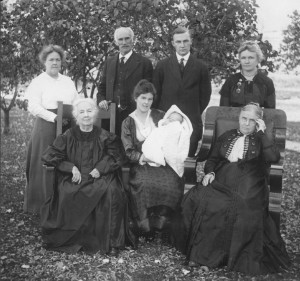
A few nights ago, I was watching Hercule Poirot on TV, working to solve a complicated mystery. At one point, he found himself stumped and said, “I am an imbecile. I see only half of the picture.” As an aspiring genealogist (read: amateur detective), I can certainly identify with the great detective in that way. I get that feeling all the time! I feel much more like Miss Lemon, who replies, “I don’t even see that.”
I guess it’s common knowledge that many aspiring (and even accomplished) genealogists see genealogy as a British murder mystery, a puzzle just begging to be solved. I know I do. And I have at least as much trouble solving my genealogical puzzles as Hercule, Miss Marple, and, dare I say it, Inspector Morse. Of course, the big difference is that those fictional detectives solve every case by the end of the episode. We genealogists can struggle for years, trying to solve our mysteries. Fortunately, very few of our cases involve murder. Continue reading Detective Stories
A revolution in one generation
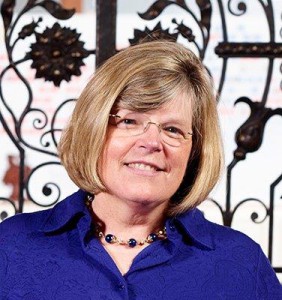 I began my publishing career in pre-computer days: manuscript was typed on a typewriter, and editing was done on hard copy. I took a freelance job from a publisher who required that I work in ink, and for that job I acquired a special fountain pen that I filled with green ink.
I began my publishing career in pre-computer days: manuscript was typed on a typewriter, and editing was done on hard copy. I took a freelance job from a publisher who required that I work in ink, and for that job I acquired a special fountain pen that I filled with green ink.
To change or remove an edit, I used ink eradicator, which came in a little brown bottle with a stopper that doubled as an applicator. The ink rule ensured that every edit was very deliberate; still, I probably used up that entire bottle of eradicator. Continue reading A revolution in one generation